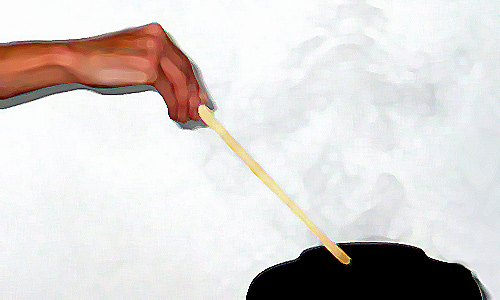My apologies for the long absence! The last few months have been a tiring time for me, and the financial crisis hasn’t helped matters. However – as one of my sensei’s tea scrolls says, Nishi nishi kore koujitsu: every day is a good day (which I think is an exhortation to practice equanimity). We may prefer nice experiences over not-so-nice ones, but when it comes right down to it, life is precious and we are lucky to be breathing!
And it’s been a great Year of the Ox* so far. I was lucky to celebrate not one but two Hatsugama-s this month … one overseen by my own sensei, and one hosted by an affiliated Urasenke center in a nearby city. There’s nothing like enjoying two “First Kettles” of the year!
There’s always a very festive feeling at Hatsugama; the participants wear brighter, flashier kimono than usual (well, at least the women do), and there’s a lot of smiling and laughter, plus a sense of excitement. The toriawase or selection of tea utensils tends to focus around the zodiacal animal of the year, or traditional New Year/long-life motifs such as cranes and willow branches – or both. Now, oxen (or cows) aren’t the most poetic-looking creatures, but I’ve noticed that a lot of this year’s items feature the akabeko, a stylized folk toy that depicts a red calf. It’s cute as a button, and also rather mysterious (although a bit less so if you click through to the Wikipedia article to read about its origins). It also holds a rather special place in the Japanese heart.
Now that so much is uncertain, in terms of jobs/investments/money and many other things besides, this seems to be a good time to make a New Year’s resolution or two about tea practice. One of mine is: I vow to be content with what I have. It’s so easy to be beguiled by tea utensils (I’m as guilty as anyone in this regard), but right now I am determined to practice contentment, and to really appreciate and enjoy – and share with others! – what I’ve already got. As Rikyu said: “Having one kettle you can make tea; it is foolish to possess many utensils.”
I also want to focus on what is really the heart of Tea, namely (among other things) the expression of genuine generosity on the part of the host, the expression of genuine gratitude on the part of the guest, and the meeting of the two in serene mindfulness. In that respect, it doesn’t matter whether the teabowl is a priceless heirloom or a piece of Tupperware. Rikyu: “Tea should not be an exhibition of what the tea man owns. Instead the sincerity of his heart should be expressed.”
And finally, I vow to put more effort into cultivating mindfulness. This means bringing my full attention to each moment, and – when my monkey-mind drifts away and I get caught in distraction – to return to the task at hand without self-recrimination, trying to see it as if for the first time. (As I learned in my first meditation retreat, when keeping my attention on my breathing for more than five seconds seemed purely impossible, each breath offers the opportunity to reawaken.) Rikyu: “When using your right hand, your attention should also be on the left hand.”
P.S. Nearly forgot. I will drink up all my matcha while it’s still good and fresh! 🙂
_____________________
*Did you know that while it’s possible to wish someone Happy New Year in Japanese (the usual phrase being Akemashite omedetou gozaimasu), there’s actually no way to say “Happy Year of the Ox [or zodiacal animal of choice]”? The best I could manage was Akemooshite omoodetou gozaimoosu. (Oh, well. At least my Japanese-pun-loving friends enjoyed it.)






